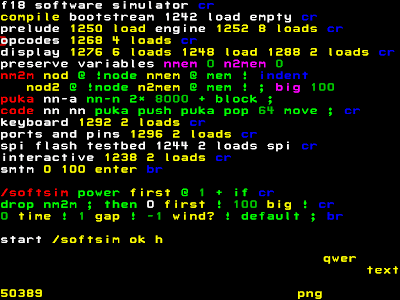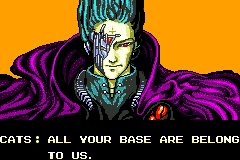Squeezing Forth into 64 Bits
November 16, 2019
Caveats
- Simplicity is in the eye of the beholder.
-
Wise and venerable practitioners have tried many methods.
And some things that should not have been forgotten were lost.
Forthopedia
- A lot of debate and thought went into the choices in Forth, but is not well documented.
- How a word came to be matters!
- Help me record "WHY?"
- https://github.com/flagxor/forthopedia
Motivation
- Oct 7, 2019 - Mac OSX 10.15 (Catalina) drops 32-bit support
- Oct, 2019 - Ubuntu 19.10 initially planned to drop 32-bit support
- Wine + gaming community prompted change to support some packages for now
Motivation
Linus Torvalds <torvalds@linux-foundation.org>
Merge branch 'x86-nuke386-for-linus'
of git://git.kernel.org/pub/scm/linux/kernel/git/tip/tip
Pull "Nuke 386-DX/SX support" from Ingo Molnar:
"This tree removes ancient-386-CPUs support and thus zaps
quite a bit of complexity:
24 files changed, 56 insertions(+), 425 deletions(-)
... which complexity has plagued us with extra work
whenever we wanted to change SMP primitives, for years.
Unfortunately there's a nostalgic cost: your old original
386 DX33 system from early 1991 won't be able to boot modern
Linux kernels anymore. Sniff."
I'm not sentimental. Good riddance.
Motivation
- SwiftForth for Windows: Windows Vista or later
- SwiftForth for macOS: Mac OS X 10.6 through macOS 10.14 (requires 32-bit library support)
- SwiftForth for Linux: Linux 2.6 kernel or later with 32-bit library support
Lamentation of Complexity
- 64-bit instruction sets are complex, grafted onto 32-bit ones.
- 64-bit calling conventions are complex, involving alignment and "redzones".
- 64-bit has become common, even though it is usually less memory effient, to allow a single complex configuration to prevail.
- Software doesn't need to be this way, but it is because it has become cumulative.
What can be made Simpler with 64-bit?
- Less need for double length words.
- 64-bits could encode a fairly complex single instruction machine?
- 64-bits is 8 bytes!, 8 letters is a lot.
ColorForth
- Source code encoded in 32-bit words
- 4-bit tag for color
- 28-bits of variable length characters

ColorForth Character Set
0 000 0 10 000 s 8 1100 000 d 16 0 001 r 1 10 001 m 9 1100 001 v 17 0 010 t 2 10 010 c 10 1100 010 p 18 0 011 o 3 10 011 y 11 1100 011 b 19 0 100 e 4 10 100 l 12 1100 100 h 20 0 101 a 5 10 101 g 13 1100 101 x 21 0 110 n 6 10 110 f 14 1100 110 u 22 0 111 i 7 10 111 w 15 1100 111 q 23 1101 000 0 24 1110 000 8 32 1111 000 ; 40 1101 001 1 25 1110 001 9 33 1111 001 ' 41 1101 010 2 26 1110 010 j 34 1111 010 ! 42 1101 011 3 27 1110 011 - 35 1111 011 + 43 1101 100 4 28 1110 100 k 36 1111 100 @ 44 1101 101 5 29 1110 101 . 37 1111 101 * 45 1101 110 6 30 1110 110 z 38 1111 110 , 46 1101 111 7 31 1110 111 / 39 1111 111 ? 47http://www.greenarraychips.com/home/documents/greg/cf-characters.htm
DSSP
- Forth cousin for the Setun-70 (ternary computer)
- Key philosophy: "one word of text - one word of machine code"
DSSP
DSSP Forth [n] IF+ A [n] 0> IF A THEN [n] IF0 A [n] 0= IF A THEN [n] IF- A [n] 0< IF A THEN [n] BR+ A B [n] 0> IF A ELSE B THEN [n] BR- A B [n] 0< NEG IF A ELSE B THEN [n] BR0 A B [n] 0= IF A ELSE B THEN [n] BRS X Y Z [n] BR c1 p1 c2 p2 ... cN pN else pN+1http://brokestream.com/daf.txt
DSSP
DSSP Forth
[ ] RP A [] BEGIN A 0 UNTIL
[n] DO A [n,0] DO A LOOP
To leave the cycle 4 break operators can be used:
DSSP Forth
EX LEAVE
EX- O< IF LEAVE THEN
EX0 0= IF LEAVE THEN
EX+ 0> IF LEAVE THEN
http://brokestream.com/daf.txt
Forth's Character Set
- Forth uses <# # #> () [] @ DATE&TIME !
- Why don't we tend to use ` ~ | {} ?
- Why do some EForths AND with $5F ?
Forth's Character Set
0123456789ABCDEF
0x@ABCDEFGHIJKLMNO
1xPQRSTUVWXYZ[\]^_
2x !"#$%&'()*+,-./
3x0123456789:;<=>?
4x@ABCDEFGHIJKLMNO
5xPQRSTUVWXYZ[\]^_
6x`abcdefghijklmno
7xpqrstuvwxyz{|}~?
0x@ABCDEFGHIJKLMNO
1xPQRSTUVWXYZ[\]^_
2x !"#$%&'()*+,-./
3x0123456789:;<=>?
4x@ABCDEFGHIJKLMNO
5xPQRSTUVWXYZ[\]^_
6x`abcdefghijklmno
7xpqrstuvwxyz{|}~?
Ctrl
Forth's Character Set
0123456789ABCDEF
0x@ABCDEFGHIJKLMNO
1xPQRSTUVWXYZ[\]^_
2x !"#$%&'()*+,-./
3x0123456789:;<=>?
4x@ABCDEFGHIJKLMNO
5xPQRSTUVWXYZ[\]^_
6x`abcdefghijklmno
7xpqrstuvwxyz{|}~?
0x@ABCDEFGHIJKLMNO
1xPQRSTUVWXYZ[\]^_
2x !"#$%&'()*+,-./
3x0123456789:;<=>?
4x@ABCDEFGHIJKLMNO
5xPQRSTUVWXYZ[\]^_
6x`abcdefghijklmno
7xpqrstuvwxyz{|}~?
Ctrl --
Forth
Forth's Character Set
- Basically a 6-bit character set!
Forth's Character Set (I lied)
- F~ ( f-proximate )
- LOCALES|
- % ^ _ aren't used
- $ is widely used for hex
Digit Conversion

: DIGIT ( c -- n ) 9 over < 7 and + [char] 0 + ; : DIGIT? ( c base -- u t ) >R [char] 0 - 9 OVER < IF 7 - DUP 10 < OR THEN DUP R> U< ;
Make Life Easier
0123456789abcdefghijklmnopqrstuvwxyz!"#$%&'()*+,-./:;<=>?@[\]^_
Even Easier?
- 6-bit * 10 = 60-bits
- Use 4-bit tag for: string(0), decimal(1), hex(2)
CircleForth
- 84 circle.fs
- 85 compound.fs
- DEMO
ESPForth (AIBOT)
- 815 espforth.c
- DEMO
Interfacing with the OS
- Kernels still use simple register calling conventions
- But they assume you know complex struct layouts...
- And hide complexity in binary blob graphics and modem drivers...
- And they're aren't technically a stable ABI
- And much of the OS is really dynamic library code
- dlopen / dlsym ?
- Write your API interface code in C ?
Matthew 22:21
Then saith he unto them, Render therefore unto Caesar the things which are Caesar's;and unto God the things that are God's.
Lead me not into Complexity
- If you use an OS facility, embrace its details.
- Try to abstain from doing so!
- Write a wrapper outside Forth if you want the capability,
instead of the whole "library".
- Simplify a GUI to just render bitmap in a window, if you just want to get pixels on the screen.
- Reduce Wi-Fi to running an HTTP server offering remote transport.
- Running multiple programs can separate concerns.
- Portability is a profound temptation.
Parser Tug and Pull
- Conventional Forth mixes if interpreting drives parsing, or parsing drives interpreting.
- Interpreter Driven: WORD, PARSE, CREATE
- Parser Driven: STATE, Number parsing
ColorForth Solution
- Mostly Parser Driven
- Color call table decides how to respond.
- Numbers are pre-parsed.
- Downside, more statefulness
Coroutines
- Parsing words yield to parser.
- Loading / evaluating words run as the parsing co-routine.
- [ and ] terminate and restart interpret / compile.
- Downside, more complexity
What I did
- Similar to ColorForth, mostly parser driven.
- WIP